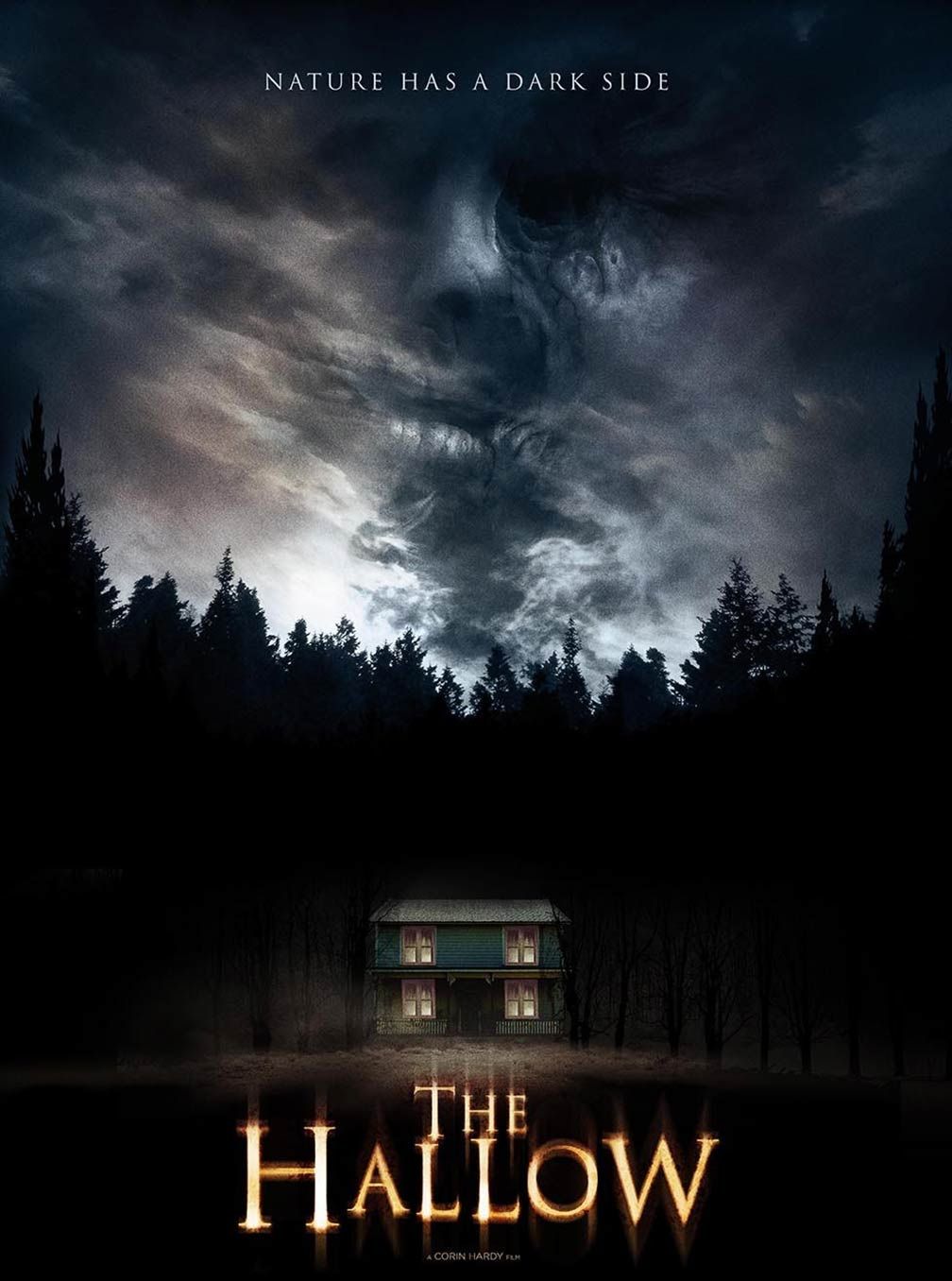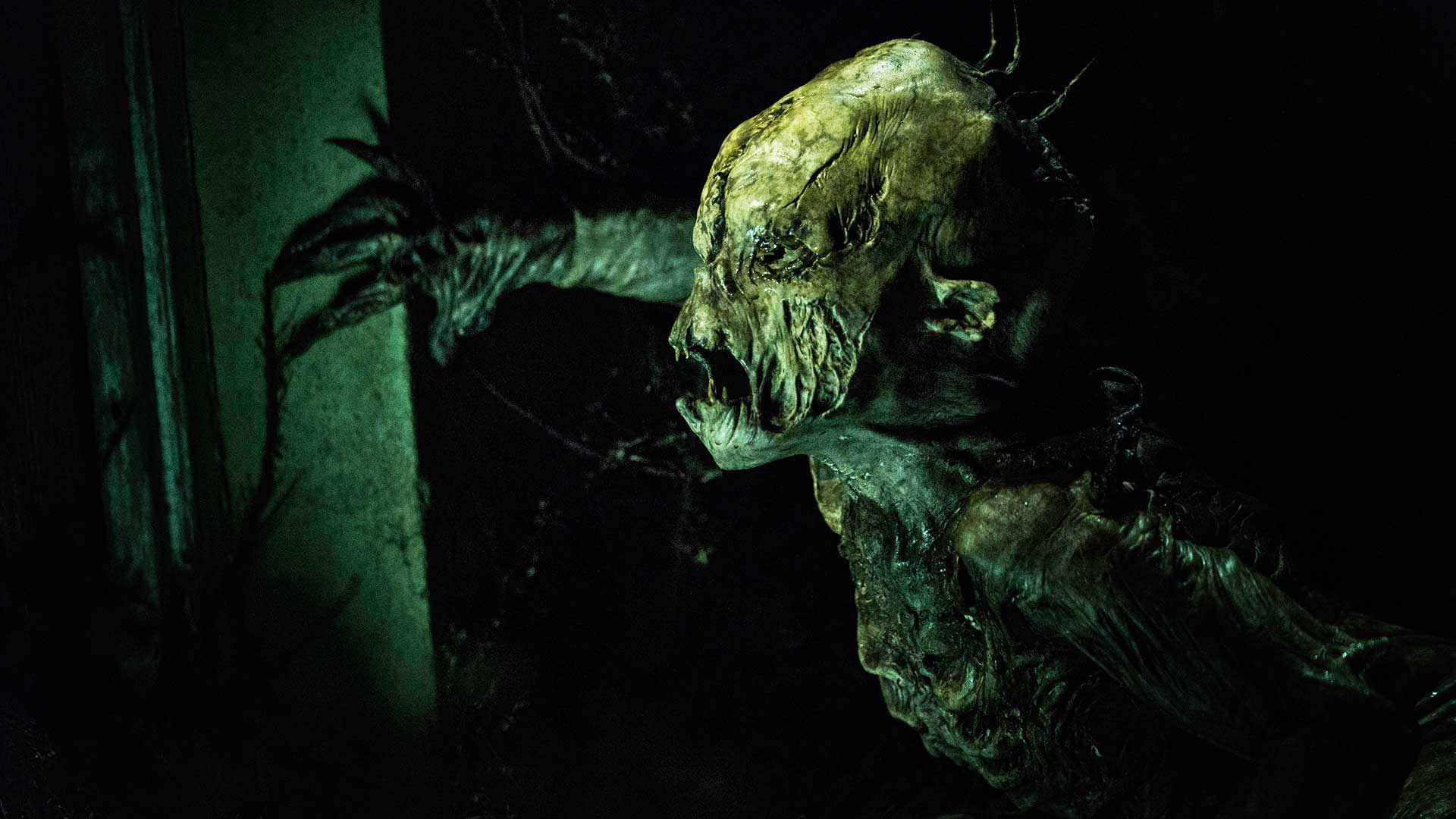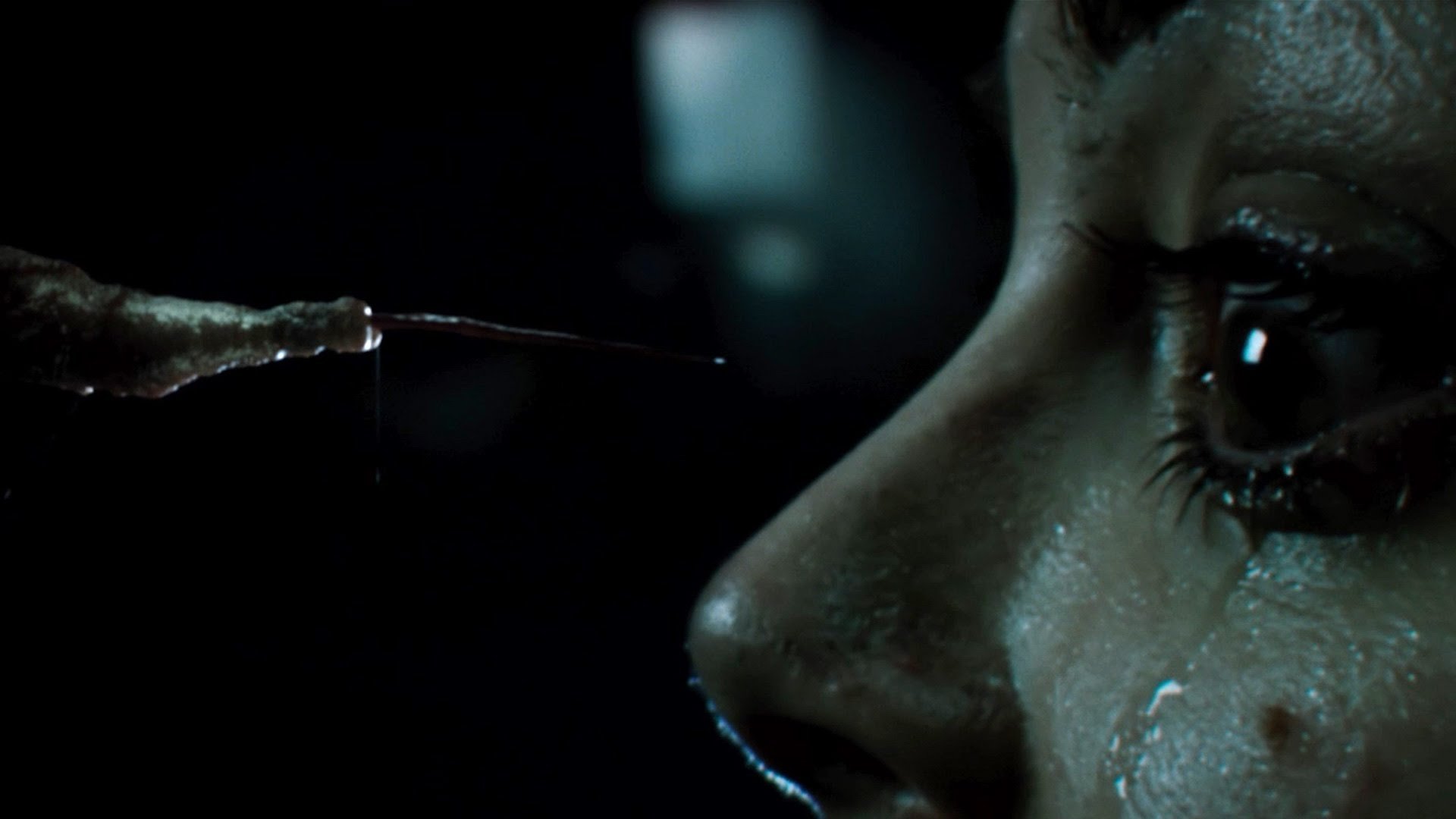Faerie folk, trolls, changelings, and other creatures from Irish mythology and folklore combine to create a terrifying film. You do not usually associate them with danger or hostility, but it turns out that they have a soft spot for kidnapping other people’s infants and replacing them with their own. Every culture has its own take on the boogeyman, and the Irish have long believed in the reality of the fay folk and the threat of changelings to their children.
It is difficult to turn away when Corin Hardy sets all of these aspects against the backdrop of a deep, gloomy wood with moss and fungus and black sludge seeping from every pore. The plot follows a young couple who have relocated to the Irish countryside with their newborn infant, and things gradually deteriorate when Adam, the father, studies the trees and discovers a black tar fungus. The film’s pacing is exactly right, and for the first time in a long time, I was truly terrified for the characters in a horror film. So, what exactly takes place in this film?
Nature has a dark side – The Hallow (2015)

The film begins with one of the most well-known horror tropes: a young family moves into a new house in a distant place, and it was shot on location in Ireland. Adam and his family, which includes his wife Clare and their infant boy Finn, have moved to a new home and are now working in a quaint millhouse in the woods.
Adam is a British conservationist and he moves through trees with his son strapped to his chest, gathering samples and appraising the forest’s logging potential on behalf of a development business, a mission that does not sit well with the grimly murmuring locals. Fun fact, films like Alien (1979), The Evil Dead (1981), The Fly (1986), and The Thing (1982) along with Irish folktales inspired the movie.
At the beginning of the film, Adam comes upon a deer carcass with black gunk flowing from it, and he takes a sample home, only to discover that it is a strange, mutating fungus upon closer inspection. On the other hand, because his job requires him to go into the woods and investigate the trees, the villagers dub him the “tree doctor,” but not out of affection. Instead, the locals are angry, scared, and apprehensive of what might happen as a result of his investigations.
Their neighbor, Colm, dislikes them the most and often threatens them to stop Adam’s work and leave the village. While Adam doesn’t pay much attention, Claire starts getting worried. The hostility between them and the villagers seems to reach its peak when the window to Finn’s nursery is broken and they assume that it was Colm’s doing. They call the police who insist that it was a bird but also warn them about the superstitious nature of the village folk and their beliefs in the Hallow’s that live in the woods.
Adam continues his work the next day, going into the hamlet to have the window frame repaired, refusing to give in to their threats or warnings. While the carpenter is assisting him, he also requests that they replace the iron rods that Claire had removed from the windows.
On the way back, things start to go horribly wrong. With baby Finn in the backseat, Adam loses control of the car and it skids across the forest road but Adam stops it just in time to avoid any major accident. He gets out to check and sees the same black tar all over the engine along with thorns and brambles growing into the engine. As he goes to look for tools in the trunk of his car, something pushes him inside and locks the trunk.
As you watch Adam try to flee and go to a crying Finn who is terrified that someone is trying to break into the car and take him away, your heart will be pounding. Finally, he makes it home by cutting his way through the rear seat.
The car is covered with scratch marks which scares him. While he was out, Colm had come to visit Claire, and to warn her, he had left behind a fairy grimoire for her to read which detailed the creatures in the woods and the phenomena of changelings. Adam and Claire decide to call the police but get increasingly worried and decide to leave in their car.
They make their way to the automobile but are assaulted by humanoid, goblin-like creatures with empty black eyes and pale skin, and while they are able to start the car, the creatures cause it to crash, forcing them to return to the house for protection. They understand that light repels them when Adam is struck in the eye with one of their spikes, so Adam proceeds to turn on the generator, after which they begin barricading the windows and doors with iron.
They then put Finn in a cupboard to protect him and Adam reads the grimoire where he learns about changes moments before Finn is abducted and taken away. Finn was actually created using a combination of animatronics and actual twins who were digitally photographed in front of a blue screen.
Adam tries to find Finn by going up into the attic, but he falls and breaks his leg, putting him unconscious, and when Claire is unable to wake him up, she dashes off into the woods on her own in search of Finn.
We watch Adam experience changes as he transforms into a Hallow himself due to the symbiotic fungi he discovered earlier when she was searching for Finn. The book had warned him if you trespass and put down roots, Hallow is thy name. His eye changes color and he starts devolving little by little.
Claire locates Finn floating in a river and carries him home, only for Adam to exclaim that it was not Finn at all. Rather than believing him, she believes he is unwell, and when he tries to attack Finn, she flees with him into the village for assistance. She knocks on Colm’s door but he turns them away at gunpoint and we see her wander the woods with only a camera flash to defend her and her baby.
The creative sound design here combines the high-pitched electronic whine of a charging camera flash to disturbing effect, evoking the baroque organic danger of Guillermo del Toro’s enchanted otherworlds.
Adam’s condition develops, and we see body horror as spikes emerge from his face and shoulders, and he wanders into the woods in search of the real Finn. He discovers him in a cave surrounded by several Hallows and manages to free him. He returns to Claire and pleads with her to pick the real Finn and she finally relents and leaves the changeling behind as she runs away with Finn and the changeling burns to ashes in the sunlight. Adam also dies in the end.
The film is at its most compelling when it examines the issue of flagrant environmental insensitivity and nature’s fury. One of the film’s primary attractions is the creature effects for the creatures, or “the Hallow.” They’re both creepy, as well as beautiful to look at in their own peculiar manner.
They are remarkable, everything you want in a creature features horror pictures, from the first clue of what they are, when they are seen briefly moving out of the shadows into the light from the taillights, to their full-on unveiling when they attack Hitchens’ home. They are available in a range of forms and sizes.
The Changelings Animalistic Humanoids Explained

The idea of changelings has been around for a long time, and it was particularly popular during the Middle Ages. Changelings and how fairies replace human newborns with one of their own are also mentioned in Irish folklore and mythology, and they are frequently depicted as dark, negative, and horrible beings that are hideous and repulsive to look at.
A changeling is a fairy who has been switched in place of a human baby. The mortal infant is taken to the country of the fairies, where he or she is raised and put to labor, while the creature left behind falls sick and dies. Even if some grow up to be adults, the community will always see them as weird. In most stories concerning changelings, they are described as unattractive, tiny old men. Babies with abnormally big bodily parts or facial traits are among the other descriptions. Basically, any flaw or deformity could indicate that a fairy abducted your child.
How is it possible to identify the difference between a changeling and one’s own child? There are three ways according to folklore. The first method is to beat the infant since it was thought that the fairies would hear the child’s cries and come to its rescue, thus returning the child they had taken.
The second way was to scare it by threatening to boil it or scald it with a hot iron rod and this is the method that Adam uses to figure out that the baby that Claire had saved was not really Finn when he threatens to stab it. The last way was to make the changeling reveal its name and age, after which it would have to be taken away by the fairies.
The fairies in the film feature greyish, wrinkled skin, large foreheads, small eyes, and short pointed fangs. An irritating fungus has infiltrated their body, which grows in massive masses and vines. They can turn humans into fairies by injecting them with the same black fungus, as well as cause rot in structures and living creatures, as seen with the house Adam and Claire live in and the deer corpse Adam discovers.
Where did this myth/folklore regarding fairies and changelings originate, though? Prior to the 1900s, killing a child was mostly motivated by financial gain. A youngster who was unable to work owing to a disability was a financial burden on the family. Especially if they grew up to be adults. In certain respects, killing a kid was considered vital to ensure the survival of the rest of the family.
This tradition can be traced all the way back to ancient Greece and Rome. It’s easy to understand how the practice may have spread and continued long after the empire had fallen apart.
When medical knowledge was poor or non-existent, these abnormalities were formerly regarded to be an indication of nefarious activity. Even as an excuse for killing an infant in exchange for the return of a healthy child.
These accounts must have alleviated some of the guilt felt by those in the family and community who chose to turn a blind eye. Because, as you can see, the parents had a good child. Theirs were taken by a fairy and replaced with one of their cursed own. Of course, the parents should do everything possible to reclaim their child. It was unfortunate if the changeling perished. However, only the fairies were to blame in this case.
For a long time, the justification was accepted. As a result, children with learning disabilities and physical deformities were subjected to terrible abuse. In fact, children were not the only ones who were subjected to violence and mistrust. While fairy stories about changeling children are more common, there are stories that say that adults can also be replaced by fairies.
As a result, they were frequently “off” or a less-than-perfect version of themselves. This would have been a simple method to explain a loved one’s unexpected onset of mental health concerns, such as depression.
Changelings are an intriguing facet of human history. They were used as a justification for acts taken against children and adults who deviated from the norm. It’s a justification for murder. Despite the fact that people largely do not believe in them, they are proof of how monsters were invented to help people live with what they didn’t comprehend. However, fairies and changelings continue to be integral parts of Irish folktale along with being culturally tied to the countries in Northern Europe.
Why should you watch The Hallow?

To say the least, The Hallow is an intriguing horror film. It features concepts and creatures that are not commonly seen in horror films, thus the utilization of Irish mythology and folk tales to transform fairies, who are generally linked with happiness and joy, into something threatening is commendable.
The visuals are stunning and create a stellar atmosphere which makes the slow-ish pace of the movie worth sitting through. The creatures are new and fascinating, with each one being slightly different from the others.
You have action, atmosphere, loss, betrayal, and fear, all in one horror movie but what makes this one truly worth the watch is the fact that you actually, genuinely fear for the young family. Corin Hardy manages to get you invested in the story, making you root for their survival and the ending is fitting because it is not too negative, nor is it too positive, making it quite close to perfect.
This one is absolutely worth watching if you appreciate mythology and folktales, or if you are searching for something fresh and different.
